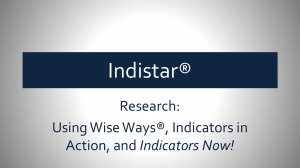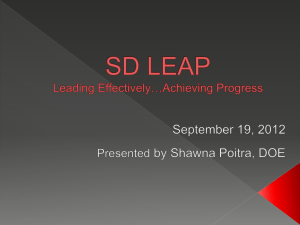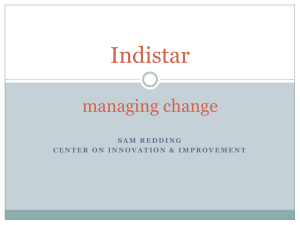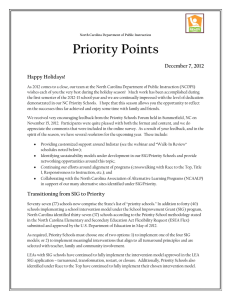Getting Started For the school Center on Innovation & Improvement
advertisement
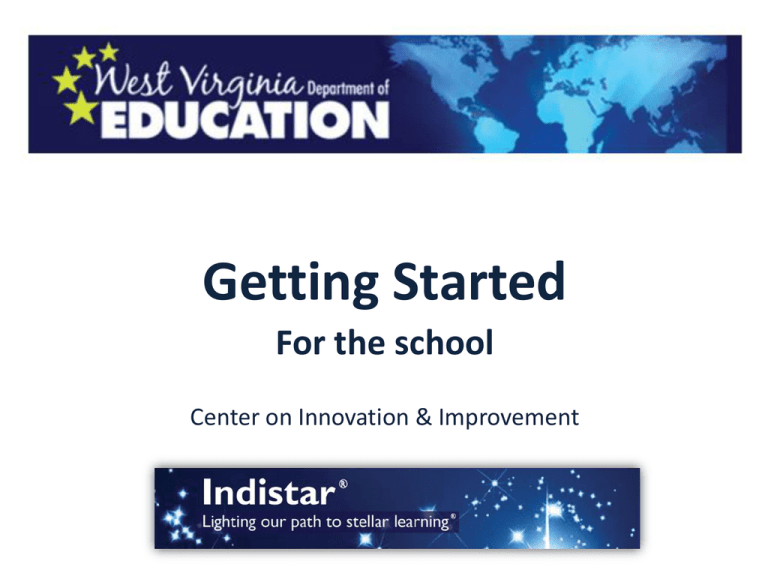
Getting Started For the school Center on Innovation & Improvement Transformation can be a complicated journey. Lots of people have ideas on where to go and what to do. They just don’t always have the same idea on how to get there. The journey can become complicated and messy. The destination gets lost in the mess. Indistar® SIG tool isn’t faster than a speeding bullet. It isn’t even the “magic bullet” every school would like to find, but it does get everyone headed in the same direction and moving toward the same destination. Ever try to drive in a city without a map or a GPS? Indistar® provides the map that EVERYONE follows. It guides a school in figuring out where it is NOW, where it wants to GO, and HOW to get there. Indistar® SIG tool clears up the confusion on who should be doing what and who has the best ideas by putting the school back in the driver’s seat. The ultimate goal in transformation is for the people associated with the school to drive transformation and create the structure for school improvement...for the sake of their own children and students. Indistar® SIG tool gets a school moving on the right path, and keeps it moving. A New Way The Old Way Indistar Accountable for Rules and Regulations Accountable for Effective Practice Data = Student Outcomes Only Data = Practice + Student Culture of Compliance Culture of Candor and Support Annual Paper Plan Continuous Improvement Process & Mail, Fax Paper Reports Transformation Focus on Programs System-Generated, Electronic Reports Top-Down Initiative, with Oversight Focus on Effective Practice LEA/School Initiative, with Support So…let’s get started. We know that Indistar® gets a school on the right path... We know it is a new way of thinking and doing... But…what exactly is Indistar® ? Indistar® is a web-based tool that guides the LEA/School team in charting its improvement and managing the transformation process. Indistar® is called different things in different states. For example, Illinois calls it Rising Star, the Bureau of Indian Education calls it Native Star, and Idaho and Oklahoma call it the WISE tool. The system is also tailored for the purposes of each state, its districts, and its schools. Indistar® is premised on the firm belief that district and school improvement is best accomplished when directed by the people closest to the students. While the state provides a framework for the process, each district team and school team applies its own ingenuity to achieve the results it desires for its students—students it knows and cares about. Before you start to think this is just another computer program that promises to increase student assessment scores, we want you to keep this in mind… the web program makes it convenient, the work of the teams is what makes the difference. We’re going to use a little advanced organizer here to get us oriented for what is to come. First, we’re going to talk about the backbone of Indistar® SIG tool: Transformation Indicators Second, we’ll talk about who works with the indicators-the cornerstone of Indistar ® : Teams. Third, we’ll talk about how the work gets done and who helps. Finally, because we know you are curious, we’ll show you the website, all the moving pieces, and all the levels of people who are involved in helping a school get to its goal destination. Indicators of Effective Practice in·di·ca·tor [in-di-key-ter] (noun) A pointer or a gauge for assessing progress toward the destination. Indicators provide the structure for building a continuous school improvement plan or transformation model structure, while still allowing each school flexibility and creativity on how it implements the plan. Indicators point the way toward effective practices. Indicators are: •Guideposts for effective practice •Plain language, behavioral (Who does what?) •Aligned with research base (Wise Ways) •Drivers of planning and improvement Indicators of Effective Practice-Samples LEA/School Teachers Principals • The LEA/School has implemented a communication plan for building stakeholder support. • The LEA/School creates a professional learning community that fosters a school culture of continuous learning. • All teachers, working in teams, prepare standardsaligned lessons. • All teachers provide sound instruction in a variety of modes: teacher-directed whole-class; teacher-directed small-group; student-directed small group; independent work; computer-based; homework. • The principal aligns professional development with classroom observations and teacher evaluation criteria. • The principal is familiar with research and best practices associated with efforts to increase learning time. Indicators of Effective Practice-Final Notes There are indicators for all levels of LEA/School staff: teams, teachers, principals, LEA/School. Indicators are meant to be discussed and worked on in teams that are practicing within a culture of candor. On the indicators for teachers, the first two words are “All teachers.” “All” means “all.” Not some. Not most. ALL. Which is the perfect segue into the next section. Teams: The cornerstone of Indistar® Leadership Team Instructional Teams The team that manages the Indistar® process and is ultimately responsible for making decisions for the school, for transformation and for school improvement. Teams that include teachers in grade level groupings, grade-level clusters, or subject areas. Responsible for planning instruction for students. Teams School Community Council A team that includes parents as the majority of its members and looks at how the school and families work together for the benefit of students. Time Teams need time to do their work and structure to do effective work. Indistar® provides benchmarks of work to be completed at specific points in time during the year. Teams: Culture of Candor Accountability to students and to each other Willingness to polish the craft together with high expectations for the adults Focus on the practice and not the person Openness to the data about student outcomes and about the practices that contribute to the outcomes Guest Login-Transparency Teams: Expectations 1. Attend scheduled team meetings regularly 2. Assess progress toward Success Indicators with a culture of candor 3. Plan for adjustments 4. Receive feedback from coaches 5. Select one member to be the “process manager” to enter information into the web system The support system: SEA, LEA, Coaches The coach is assigned to work directly with the school team to support its work in the Indistar® system. The coach may view the work of the school to which he/she is assigned. The LEA will work with the school and the leadership team. This may be the superintendent or some other internal LEA support. The LEA will be given access to view the work of the school. The SEA provides support to the school through the statewide system of support. The state adopts Indistar®, selects indicators, sets benchmarks, provides coaches, trains districts/coaches/schools. The state may review all the work of the LEA/Schools through the state administrative page. The support system: Extras To keep everything running smoothly, we also offer: • Indicators in ActionTM—videos that show the indicators being implemented in real schools with real teachers, •Wise Ways®—research briefs to guide the team in making decisions on the indicators, and •Technical assistance from the Center on Innovation & Improvement’s helpful client relations team. Indicators in Action Wise Ways Technical support from CII And now, the moment you’ve all been waiting for… A quick reminder before we get all caught up in the wonders of the web world… INDISTAR® THE WEB SYSTEM NOW SHOWING IN YOUR SCHOOL. Welcome to the Dashboard: Control Central Every school is assigned a unique login and password that gives it access to its own school’s dashboard. The login is given to the principal and a staff member that the principal names as the process manager. The principal and process manager are the only two people in the school who work in the actual web system. When the principal or process manager logs in, they start at the dashboard. Dashboard: Features School Name Indicator-Based Planning Tools Forms to Complete Report Name: Reports to Submit Other Documents/Web Pages Leading Indicators Lagging Indicators 1. Number of minutes within the school year 2. Student participation rate on state assessments in reading/language arts and in mathematics, by student subgroup. 3. Dropout rate 4. Student attendance rate 5. Number and percentage of students completing advanced coursework (e.g., AP/IB), earlycollege high schools, or dual enrollment classes. 6. Discipline incidents 7. Truants 8. Distribution of teachers by performance level on LEA’s teacher evaluation system 9. Teacher attendance rate 1. AYP status 2. Which AYP targets the school met and missed 3. School improvement status 4. Percentage of students at or above each proficiency level on state assessments in reading/language arts and mathematics (e.g., Basic, Proficient, Advanced), by grade and by student subgroup 5. Average scale scores on state assessments in reading/language arts and in mathematics, by grade, for the “all students” group, for each achievement quartile, and for each subgroup 6. Percentage of limited English proficient students who attain English language proficiency 7. Graduation rate 8. College enrollment rates Main Menu When the Transformation Implementation Indicators link is selected from the dashboard, the Main Menu screen appears. The SIG/Transformation Process includes 6 Steps: 1) Register School, 2) Provide School Information, 3) Form Team, 4) Assess School Indicators, 5) Create School Plan, and 6) Monitor School Plan. Also provided are tutorial videos to walk you through each Step, and, in the right hand corner, resources, reports, ways to set up agendas and keep minutes, and access to coaching comments. “Where are we now?” provides a quick glimpse of the work of the school team in graphs and reports. Steps 1, 2, and 3 • During the initial set up of Indistar®, the state or district provided the information for the school. When the principal and process manager receive their login and password, they should check the Register School information for accuracy and to make sure a current email address is provided for both. Provide School Information Form School Team • Indistar® provides a place for the school to enter demographic information as well as assessment information. • As mentioned earlier, the Leadership Team or Transformation Team—whatever it is called in your school—is the cornerstone of the work with Indistar®, transformation and continuous school improvement. Team members should be selected for their willingness to serve and their enthusiasm for moving the school forward. Information on team members is entered in Step 3. Got that done? Feeling pretty good? Great!!! Now…the real work begins. Step 4: Assess School Indicators This is where the work of the team kicks in. A word to the principals out there— don’t be thinking you can do this all by yourself. You can’t. You need the team. To the principals that think the team members can do it all by themselves—they can’t. They need you. Step 4: Assess School Indicators At the leadership team meeting, after reading the research provided in the Wise Ways®, the team will discuss the indicators. The team decides if the indicator has no development or implementation in their school, limited development or implementation, or full implementation in their school. Don’t forget the culture of candor. There are no “extra points” for saying you are fully implemented on an indicator. Step 4: No Development or Implementation If the team decides there is no implementation, it then decides if the indicator is not a priority or if it will be included in the school improvement plan. If it is not a priority, the team must provide information on why it is not a priority. Step 4: Will Include in Plan/Limited Development If the team decides it will include the indicator in their plan or if the team assesses the indicator as Limited Development, then the team will decide if the indicator is a high priority (priority score) and how easy it will be to accomplish (opportunity score). The team will also need to describe the current level of development of that indicator in the school. Step 4: Full Implementation If the team decides the school fully implements the indicator, the team will give evidence that the indicator is fully implemented and describe how the implementation will be sustained. Keep in mind, the evidence provided is to prove to the school and its stakeholders (students, teachers, staff, parents, school boards, etc.) that the indicator is fully implemented. Step 5: Create School Plan Indicators that were assessed as being included in the plan or limited development now move into Step 5 to create a plan for that indicator. Indicators that were assessed as not a priority or fully implemented will not appear in Step 5. Indicators are now called Objectives. Step 5: Create School Plan In Step 5: Create School Plan, the leadership team assigns a team member to be responsible for the Objective, describes how the Objective will look in the school when it is fully implemented, describe what they will need to gather to provide evidence when it is fully implemented, create tasks to reach the Objective, assign people to the tasks, and assign dates by which it will all be completed. Whew. No one ever said school improvement was easy work. Step 6: Monitor the Plan Step 6 is where the rubber meets the road. It’s been all fine and good to create a transformation plan. But you must continually implement and monitor the process to achieve true transformation. This isn’t like the old school improvement plans that you dust off once a year. Indistar helps you maintain a continuous improvement process in your school...exactly what it takes to create transformation in your schools. The plan has been made. Now it’s time to roll up the sleeves and get to work putting the plan in action. A plan for each Objective. Step 6: Monitor the Plan At each leadership team meeting, the team can review the list of tasks that were created for each Objective, checking with the team member responsible for the progress of the work. In Step 6, the team will check off each task as it is completed. When all of the tasks are completed for one Objective, the team will decide if the Objective has been met. If it has—CELEBRATE! Then give your evidence of full implementation, describe your experience in completing the Objective, and explain how you will sustain the work. Step 6: Monitor the Plan Sometimes, just completing the tasks doesn’t quite reach the goal. That’s okay. Just go back and create more tasks. Sometimes, the team can’t reach a decision if the Objective has been fully implemented or not. That’s okay too. The system will keep reminding you that it either needs more tasks, or the team needs to determine that it is fully implemented. Indicators in Action Wise Ways Technical support from CII Remember, you are going to get a LOT of support. Not only from your state, district, and coach, but also from all the resources and tools found in the system itself: Wise Ways®, Indicators in ActionTM, links to helpful website, and CII’s technical assistance. Some Extra Information: Levels of Access Principal and Process Manager – Enter and edit information Guest Login – Read-only school progress reports and plans for faculty, parents, school board Coach and District Liaison– Read-only and enter coaching comments LEA – Work with the school transformation team; Readonly access to the school’s plan using the LEA login SEA—Provide support to the LEA and school for the transformation process; read-only in school process Some Extra Information: We’re talking convenience, Vern Transformation Process with the school satisfying itself for benefit of its students Plan Your Meetings (Agendas, Minutes, Worksheets) Resources Electronic Submission of Reports Coaching Comments It Bears Repeating There’s no magic in the web system. It does help keep a school focused on what really matters, and keeps the conversations centered on the professional practices of the people most closely connected to the students in the building, but the real magic happens in the work of the teams. Thank you. You’ve been a great audience. For technical assistance please contact: Center on Innovation & Improvement Email: indistar@centerii.org Your school coach Or your state’s system administrator
